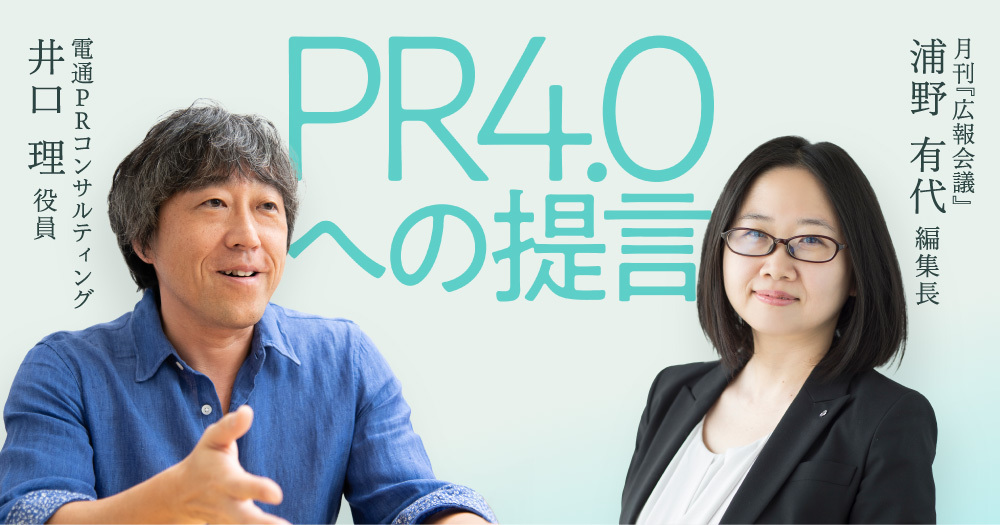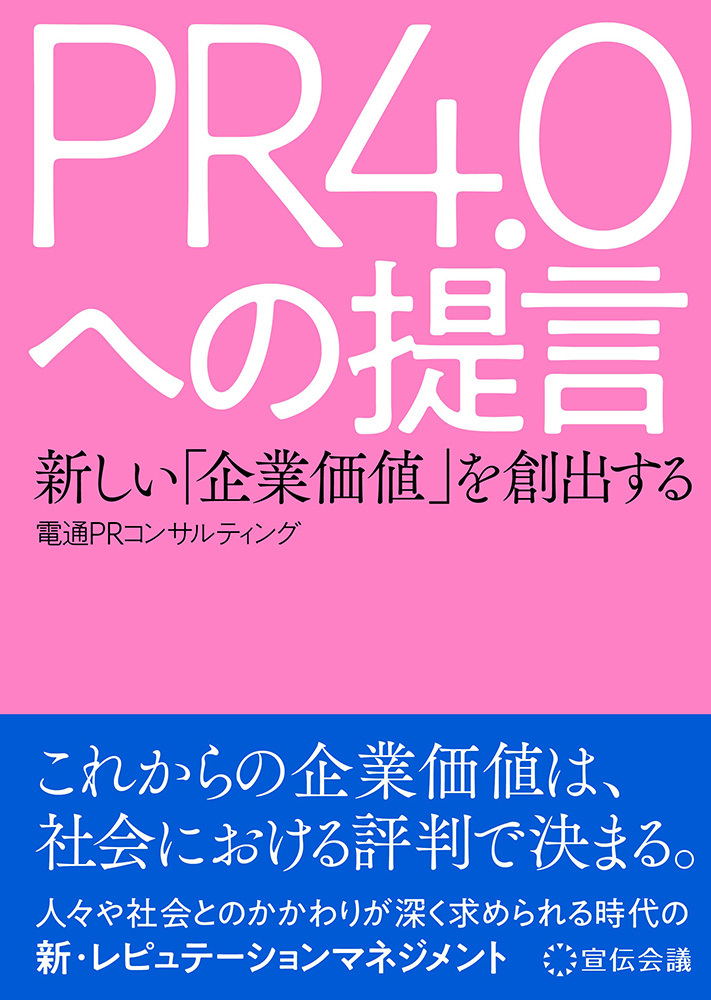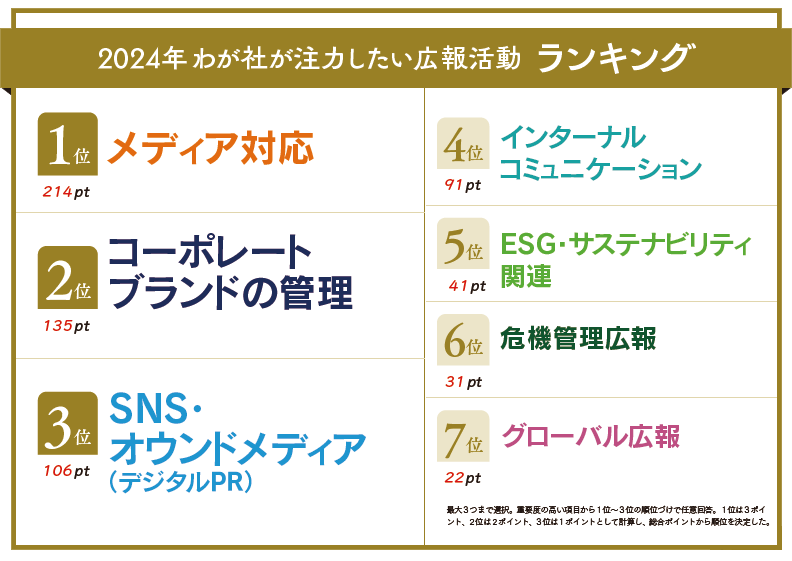Note: This website was automatically translated, so some terms or nuances may not be completely accurate.
Unwavering thinking and purpose will pave the way for PR's future!

Urano Yuyo
Editor-in-Chief of the Monthly "Public Relations Conference"

Iguchi Osamu
PR Consulting Dentsu Inc.

Against the backdrop of accelerating business environment changes, what should public relations and PR look like in this new era of creating new "corporate value"? "Proposals for PR 4.0," published in April 2024, examines the future of PR through six key trends and seven essential perspectives you need to know now.
To coincide with the publication, a special dialogue on the outlook for public relations and PR entering a new stage features Aki Urano, Editor-in-Chief of "Public Relations Conference," who authored the book's concluding commentary, and Satoshi Iguchi, Executive Officer at PR Consulting Dentsu Inc., representing the co-authors.
In this first part, they discuss how PR should move forward, touching on various perspectives of change. They address challenges many companies and organizations face today, such as the "2024 Problem" where labor shortages worsen amid the current era of mass job changes, and the need to strengthen corporate branding.

Why did "corporate branding" suddenly gain prominence in 2024?
Iguchi: First, thank you for agreeing to provide commentary for this book. Thanks to you, the external response has been very positive. While this book proposes changes in PR and its ideal form, Editor-in-Chief Urano, what changes have you actually observed in the PR field, and what concerns you? Could you share your thoughts on the book along with these insights?
Urano: Based on the results of the reader survey we conduct annually at the end of the year for "PR Conference," there's one aspect of PR/public relations changes that caught my attention. We always ask, "What PR activities will you focus on next year?" In 2023, the top priority was "Media Relations," followed by "SNS/Owned Media." However, for 2024, the top priority remained firmly "Media Relations," but the next priority was "Corporate Brand Management." It jumped up significantly from fourth place last time.

https://mag.sendenkaigi.com/kouhou/202402/public-relations-plan/028556.php
Iguchi: Why do you think corporate branding has risen this year?
Urano: Half of respondents cited "strengthening recruitment" and "enhancing internal communication" as reasons. In this era of mass job-hopping, organizations are rethinking how they engage with current employees and future hires. The renewed focus on labor shortages due to the 2024 problem is also a factor.
How purpose-driven internal branding evolves next is what I'm most focused on among recent changes. In "Proposals for PR 4.0," this aligns with Chapter 3. I get the impression many readers connect deeply with the internal branding discussion.
Iguchi: I see. Feedback from university PR officers on the book echoed this sentiment exactly. One said, "PR tends to focus outward, but this made me realize that external PR is only possible because of internal engagement. Strengthening internal PR is what's most needed now."
Urano: Within the "PR Meeting" series, two installments related to internal branding particularly stood out. The first was the observation that "Communicating something and having it understood are different; PR must be sensitive to this distinction" and "It's common for top management to only announce policy, then consider it 'communicated' simply because they held an internal briefing session" ( published in the July 2022 issue ).
The second was the observation: "Internal PR needs an entertainment perspective," "It's about captivating, not just showing," and "We must have a perspective on how to engage employees" ( published in the September 2021 issue ). I hear this so often now when interviewing sources. The scope of PR has truly expanded to include these areas.
Iguchi: Yes, PR must track how the audience perceives or relates to the message. I feel this same emphasis has been growing within internal communications too.
Urano: This year, various new employee orientation ceremonies were featured in the news. For example, companies that adopted a dress code-free policy effectively conveyed their commitment to respecting diversity. Another company surprised attendees by having the president deliver their opening address via an AI avatar video, only for the actual president to then take the stage. This demonstrated a proactive stance toward embracing new technologies. While clearly stating the company's direction—"This is where we aim to go"—is certainly important, communication that translates this vision into everyday experiences feels particularly effective for building empathy.
Precisely because we live in an era of rapid change, where do we anchor our foundation?
Iguchi: As various media platforms emerge and communication methods evolve, it's natural that the methods themselves must be updated, and there's a constant need to convey new information.
On the other hand, precisely because we live in such a rapidly changing era, isn't it crucial to maintain a firm foundation? Challenging new methods is certainly important, but to do so, you need a solid foundation. For those seeking methods and how-tos, I hope this book can be useful in the foundational thinking process of determining where to place that foundation.
Urano: As I mentioned in the commentary, I believe this book offers many highly stimulating proposals for those seeking to break free from precedent-based approaches and gain fresh perspectives when formulating PR strategies. Speaking of which, I noticed someone on X posting the seven proposals from the book. I suspect they wanted to keep the future direction of PR in mind. I think this book truly points the way forward.
The PR Society of Japan and the Marketing Association successively revised their definitions. What does the emergence of PR 4.0 immediately afterward signify?
Urano: In 2023, the Japan Public Relations Society announced its "definition of public relations," right? Amidst the increasing complexity and diversification of PR's scope and methods, I think it provided an opportunity to return to the fundamentals and reexamine the concept of PR. Then, in 2024, this "Proposals for PR 4.0" was published. Even from the book's title, it clearly conveys that "PR is something that changes and evolves" (laughs).
Just as we were gaining a real sense of PR's ideal form and expanding scope through the latest definition, this book arrived. It showed us the direction forward and the underlying thinking – truly perfect timing.
Iguchi: Thank you. Looking back, the first significant surge in interest in PR that everyone remembers was "Strategic PR." The combination of "strategy" and "PR" felt fresh. But ultimately, it was about how to leverage PR from a marketing perspective. The focus was mainly on technical aspects—how far to spread and expand information reach, essentially using information contact tactics to get people to purchase products or services.
Now, however, I believe the value criteria at the point of purchase are shifting. People want to like the company itself, the provider of the product or service, and think, "I want to buy this because it's from this company." In that sense, I think PR, which governs corporate branding, will also take on the role of supporting the very foundation of marketing.

The Japan Marketing Association also refreshed its definition in January 2024 for the first time in 34 years, stating: "(Marketing is) a concept and process for realizing a richer, more sustainable society by creating value together with customers and society, widely disseminating that value, and thereby cultivating relationships with stakeholders."
When I heard that, I thought, "Finally, PR has swallowed up the marketing industry." Listening to society's voice, staying close to consumers, sharing their values, and building relationships with stakeholders is precisely what PR has been advocating for over a decade.
This represents a new stage in PR thinking, distinct from the "strategic PR" of yesteryear.
Urano: In that sense, the toy manufacturer case featured in "Public Relations Conference" is emblematic. Their owned media article (note) detailing the decision to end production of a long-selling doll that had lasted about 25 years reportedly generated significant response. While discontinuing a beloved product might seem inherently negative, they carefully explained the reasons tied to their purpose, successfully turning it into a positive impression. ( Published in the June 2024 issue )
The company admitted that while engaging children's curiosity should be their purpose, they had inevitably focused on adult perspectives, chasing trends and striving to maintain products. To stay true to their stated purpose, they decided to engage children's curiosity in a form different from their previous dolls. This was written in a positive light. In response, users sent messages of gratitude, and some even became new shareholders.
This approach to communication, as Mr. Iguchi mentioned earlier, has entered a stage entirely different from PR focused solely on selling products to customers. I believe the PR function of broadly and objectively viewing stakeholders is becoming a significantly larger presence within organizations.
Iguchi: That's right. According to the latest findings from our Corporate PR Strategy Institute, individual investors rely more heavily on earned media and owned media for corporate information than on traditional investment media. When selecting investments, the results showed they prioritize governance over environmental and social factors within ESG. Governance ranked in the top six out of the top ten criteria.
While governance might be thought of as simply whether management is sound, the survey results showed that investors now evaluate companies based on human capital – whether management properly values people. They are increasingly considering investments based on evaluating a company's stance and approach as a corporate citizen. The E and S in ESG are becoming standard, and now the focus is on G. I increasingly feel this represents an evolved relationship, where more people are voicing opinions about a company's social role and how it should behave.
Urano: In "Proposals for PR 4.0," I recall a strong emphasis on companies communicating their stance toward societal challenges. Was there survey data supporting that?
Iguchi: We wrote it suggesting that's the direction things were heading. But seeing this data emerge retrospectively makes you think, "Oh, we're already there?" It's caught up with reality so quickly that I might have to write PR 5.0 soon (laughs).
Corporate BCP (Business Continuity Planning) used to focus on technical aspects like data management and security, but now it's shifting to fundamental, real-world BCP issues like losing the workforce.
Urano: The message that "If you don't properly implement internal branding, you'll lose your workforce—it's a crisis threatening the company's survival" really hits home strongly now.
For example, Chapter 7, "Perspective 5" of "Proposals for PR 4.0" includes a conceptual diagram of narrative. It explains the idea that employees, being closest to the company, convey its value and passion by speaking about it. An ideal environment would be one where employees themselves start talking about the company's appeal as a workplace, and where shareholders, investors, and job seekers can see this.
While creating opportunities to deliver high-impact corporate messages can be challenging, another direction could be gathering and sharing the small stories told by each individual employee.

Iguchi: That's right. On the other hand, with social media now firmly established, employees openly sharing their personal experiences means everyone can see behind the scenes of a company. This makes it essential to build strong empathy with employees, not just for risk management. Beyond risk management, we must create a workplace environment where our closest collaborators – our employees – can truly work with passion. For that, employees must fundamentally resonate with the company's purpose.
Urano: Yaho Brewing, featured in the corporate case study in Chapter 3, also focused intensely on how to permeate their philosophy throughout the company, didn't they?

Iguchi: Yes, companies like that have a different level of employee passion. Data also shows that the more successful a company is, the more relentless it is in embedding its purpose and corporate philosophy and building systems around them. After all, without workers, a company's survival is at risk. We've entered an era where we must seriously consider not only strengthening recruitment but also building relationships with our current employees.
Neither "social commitment" nor "collective impact" are new terms
Iguchi: "Perspectives on PR 4.0" examines the future of public relations and PR through seven key perspectives. The terms highlighted within these perspectives have actually been in use for over a decade. "Social Commitment" was used after the Great East Japan Earthquake, and "Collective Impact" was proposed in the US around 2011. These terms have been used in line with the concerns of their respective eras. However, I believe the companies and organizations leading the way today are those that have consistently articulated these concepts without wavering, made them visible, and then translated them into real action.
For example, as mentioned in this book, Nike's case. Their use of Colin Kaepernick in ads opposing racial discrimination, or their campaigns supporting same-sex marriage. By persistently acting on the belief that people are equal both on and off the field, they gained widespread empathy and established an unshakable brand position.
Urano: While the seven perspectives presented here aren't new concepts, companies that truly practice them are quite advanced and probably not that numerous. For those who want to challenge themselves but haven't yet taken action, I'd love to hear your advice.
Iguchi: It comes down to whether you can be proactive with conviction and resolve. Hesitating risks falling behind. While Western companies are often praised for their innovation and execution, Japan also has companies and organizations where a spirit of challenge is deeply ingrained.
Of course, we don't welcome backlash, but diverse opinions are natural. The ability to effectively build empathy, even with negative aspects, like the toy manufacturer mentioned earlier, will be increasingly demanded in PR going forward. Even if controversy arises, the skill lies in accepting it and then considering what perspective to communicate next. Ultimately, what captures people's hearts isn't technique but mindset. What matters most is sensitively perceiving social conditions and determining the company's stance.
Constantly monitoring the external environment and responding in real time—that's part of what makes PR, distinct from advertising, so fascinating.
(Postscript)
In a rapidly changing business environment, amid instantly shifting trends and diverse values, I feel it's becoming increasingly vital for companies and organizations to hold firm convictions and purpose. Steadfast thinking enables consistent messaging, while purpose and philosophy imbue that message with genuine value and direction. When these elements align, can't we build trust and empathy that remains unshaken by any headwinds? Precisely because we live in an era of rapid change, where do we anchor ourselves? "Unwavering Thinking and Purpose" will be the key to unlocking the future of PR.
The second part of our discussion, "PR Moves to a New Stage: Proposals for PR 4.0," will delve into key perspectives from among the seven identified. We will also explore in depth the new approaches required for PR going forward, even for companies with limited resources, such as those operating with a single PR person.
(Text: PR Consulting Dentsu Inc., Ikuyo Nakagawa)
Was this article helpful?
Newsletter registration is here
We select and publish important news every day
For inquiries about this article
Author

Urano Yuyo
Editor-in-Chief of the Monthly "Public Relations Conference"
Joined Sendenkaigi in 2003. Served as Editor-in-Chief of "Editorial Meeting," Editor-in-Chief of "Sales Promotion Meeting," and Head of the Book Department before assuming the current position in 2020. For the specialized magazine "PR Meeting" for PR practitioners, covers media relations, risk management, internal communications, and other practical methods and approaches useful for real-world application.

Iguchi Osamu
PR Consulting Dentsu Inc.
Executive Officer
Chief PR Planner
We handle a wide range of services, from developing data-driven corporate PR strategies to strategic PR for products and services, viral campaigns utilizing video content, and municipal PR. Proposes initiatives like "PR IMPAKT," which creates content likely to trend in news and social media, and "Information Flow Structure," which unravels information pathways across media. Over 30 years of experience in PR agencies. Recipient of numerous awards including "World's Top 50 PR Projects," "Cannes Lions Grand Prix," "Asia Pacific Innovator 25," and "Gunn Report Top Campaigns 100." Has served as a judge for numerous domestic and international awards, including Cannes Lions, Spikes Asia, SABRE Awards Asia-Pacific, PR Awards Asia, Japan PR Association PR Award Grand Prix, and Nikkei SDGs Idea Competition. Author of "The Essence of Strategic PR: Five Perspectives for Practice" and co-author of "Learning from 17 Successful Cases: Local Government PR Strategy."


